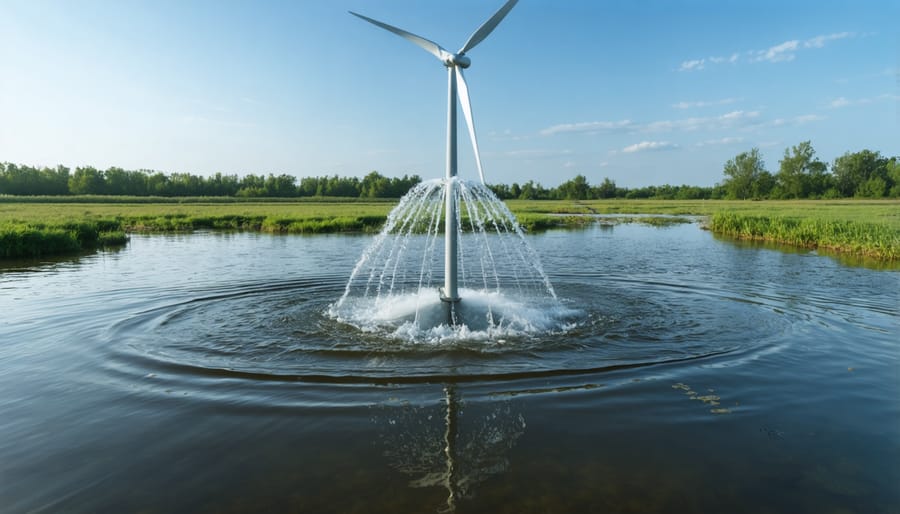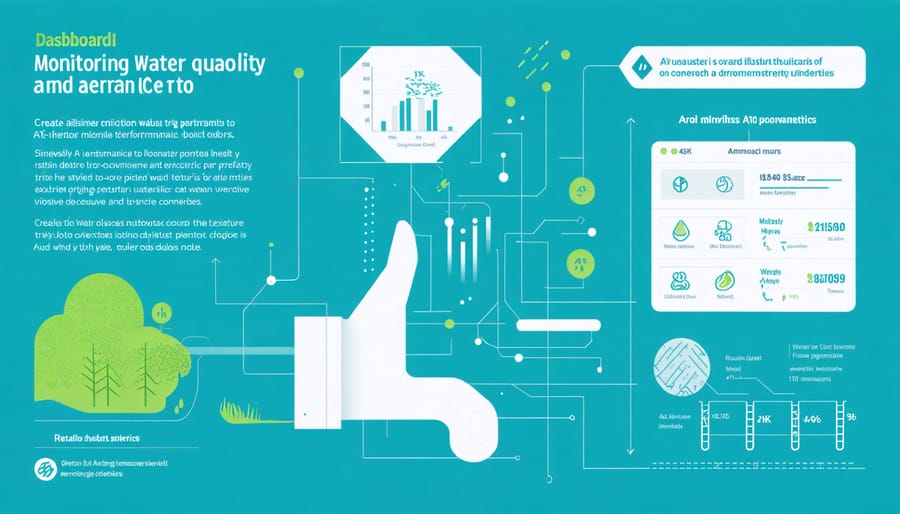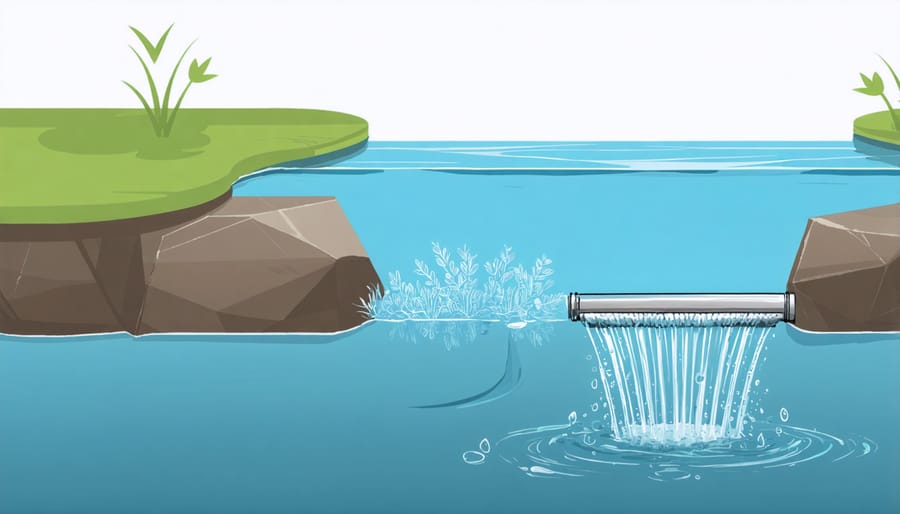
Wind-Powered Pond Aeration: Smart Technology Meets Natural Energy
Harness the power of nature to keep your pond healthy and vibrant with wind-driven aerators – an eco-friendly solution that works around the clock without electricity. These ingenious devices transform gentle breezes into life-giving oxygen for your aquatic ecosystem, creating natural water circulation that benefits fish, plants, and beneficial bacteria alike. Unlike traditional electric aerators, wind-powered systems operate silently and sustainably, requiring minimal maintenance while providing consistent aeration even in remote locations. Whether you’re managing a backyard pond or a larger water feature, wind-driven aerators offer a cost-effective way to maintain water quality and prevent stagnation, all while reducing your environmental footprint.
This introduction blends practical benefits with environmental consciousness, speaking directly to DIY enthusiasts and pond owners while maintaining an accessible, engaging tone. It avoids technical jargon while still conveying the essential functionality and advantages of wind-driven pond aerators.
How Wind-Driven Aerators Transform Pond Health

The Science Behind Wind Aeration
The magic of wind-driven pond aerators lies in their elegant simplicity. When wind blows across your pond, it turns the aerator’s windmill or turbine, which acts like a giant pinwheel. This spinning motion creates mechanical energy that’s transferred down through a shaft into the water below.
At the bottom of the shaft, you’ll find a diaphragm or air pump that moves up and down with each rotation. As it moves, it creates air bubbles that rise through the water column. These bubbles do two important jobs: they break up the water’s surface tension and create vertical circulation patterns in your pond.
Think of it like stirring a cup of coffee – as the bubbles rise, they pull bottom water up to the surface where it can absorb oxygen from the air. This creates a natural mixing effect that distributes oxygen-rich water throughout your pond. The process also helps release harmful gases like carbon dioxide and methane that can build up in deeper water.
The best part? This whole process happens automatically whenever there’s a breeze, requiring no electricity or manual intervention.
Key Benefits for Your Pond Ecosystem
Wind-driven pond aerators offer remarkable benefits for creating a healthy pond ecosystem. By continuously circulating water and introducing oxygen, these natural systems dramatically improve water quality. Your fish will thrive with increased oxygen levels, showing more energy and better appetite. Plus, you’ll notice they’re less stressed during hot summer months when oxygen levels typically drop.
One of the most visible benefits is the reduction in algae growth. Better circulation prevents water from becoming stagnant, making it harder for algae to take hold. This means clearer, more beautiful water without the constant battle against green blooms. You’ll also notice fewer unpleasant odors as proper aeration helps break down organic matter more efficiently.
The bottom layer of your pond benefits too. Enhanced oxygen circulation helps beneficial bacteria thrive, naturally breaking down waste and keeping the water clean. This creates a more balanced environment where aquatic plants can flourish and fish can access the entire pond depth comfortably. Best of all, these improvements happen naturally, without the need for chemicals or electricity!
AI Integration: Making Wind Aeration Smarter
Real-Time Monitoring and Adaptation
Modern wind-driven pond aerators can now work hand-in-hand with AI pond management systems to create a smart, responsive environment for your pond. These intelligent systems use sensors to continuously monitor crucial water parameters like oxygen levels, temperature, and pH. Think of it as having a 24/7 pond guardian that never takes a break!
When the sensors detect changes in water quality, the system automatically adjusts the aeration patterns. For example, if oxygen levels start dropping during a particularly warm afternoon, the AI can optimize the aerator’s position to maximize wind capture and boost oxygen circulation. It’s like having a smart thermostat for your pond!
The real beauty of these systems is their ability to learn from patterns over time. They can predict when your pond might need extra aeration based on weather forecasts, seasonal changes, and historical data. You’ll receive notifications on your smartphone when conditions change, and the system will suggest adjustments to keep your pond healthy.
For DIY enthusiasts, many of these monitoring systems are surprisingly easy to install and maintain. Most come with user-friendly apps that display real-time data in easy-to-understand graphs and charts, making pond management more accessible than ever before.

Predictive Maintenance and Optimization
Modern wind-driven pond aerators are getting smarter thanks to artificial intelligence and predictive maintenance technologies. These innovations help pond owners stay ahead of potential issues and optimize their aeration systems for maximum efficiency. By connecting your wind aerator to smart pond monitoring systems, you can track important data like wind speeds, operating hours, and performance metrics in real-time.
The AI-powered system learns from this data to predict when maintenance might be needed, such as bearing replacements or blade cleaning. It can alert you before small issues become bigger problems, helping you avoid unexpected breakdowns and costly repairs. For example, if the system notices decreased efficiency during certain wind conditions, it might suggest checking the blades for debris or wear.
These smart features also help optimize your aerator’s performance by analyzing wind patterns and adjusting the system accordingly. The AI can recommend the best times to supplement with backup aeration or suggest ideal positioning based on prevailing winds in your area. Some systems even integrate with weather forecasts to prepare for upcoming conditions.
For DIY pond enthusiasts, these predictive tools take the guesswork out of maintenance scheduling and help ensure your wind aerator operates at peak efficiency year-round. While the technology might sound complex, most systems are designed with user-friendly interfaces that make it easy to monitor your aerator’s health and follow maintenance recommendations.
Choosing and Installing Your Smart Wind Aerator

Sizing and Placement Considerations
Choosing the right size and placement for your wind-driven pond aerator is crucial for optimal performance. For sizing, a good rule of thumb is to select an aerator that can handle about 1-2% of your pond’s surface area. For example, if your pond is 1,000 square feet, look for an aerator that can effectively aerate 10-20 square feet.
Height matters too! Your wind-driven aerator should be mounted at least 6-8 feet above the water surface to catch sufficient wind. Make sure there’s enough clearance between the water and the bottom of the diffuser to prevent splashing during operation.
For placement, consider these key factors:
– Prevailing wind direction in your area
– Obstacles like trees or buildings that might block airflow
– Areas of your pond that need the most oxygen
– Aesthetic impact on your landscape
Install your aerator where it can catch the most wind, typically on the side of the pond that faces the prevailing winds. Avoid placing it in sheltered areas or too close to tall structures that could create wind shadows.
For larger ponds, you might need multiple units. Space them evenly around the perimeter to ensure comprehensive coverage. Remember, it’s better to slightly oversize than undersize – this gives you flexibility during periods of low wind activity.
Installation and AI Setup Tips
Installing a wind-driven pond aerator is surprisingly straightforward, and integrating it with smart monitoring systems can give you even better control over your pond’s health. Let’s break it down into manageable steps.
First, choose an open location where your wind-driven aerator will catch maximum breeze. Typically, you’ll want to position it at least 20 feet from any tall obstacles like trees or buildings. Secure the mounting pole firmly into the ground, ensuring it’s perfectly vertical using a level.
For the airlift system, place your diffuser in the deepest part of your pond. Run the airline tubing from the wind turbine to the diffuser, keeping it as straight as possible to maximize efficiency. Use stakes or weights to prevent the tubing from floating.
If you’re adding smart monitoring capabilities, install your water quality sensors near the diffuser. Most modern sensors connect via Bluetooth or Wi-Fi to your smartphone. Mount the control box in a waterproof housing near your pond, but above the waterline.
Many smart systems now offer automated alerts when oxygen levels drop below optimal ranges. You can program these to notify you when wind conditions aren’t sufficient for adequate aeration, allowing you to activate backup systems if needed.
Remember to check all connections for air leaks and ensure your smart monitoring system is properly calibrated before finalizing the installation. Regular maintenance checks will keep both your wind aerator and AI monitoring system running smoothly.
Maintenance and Troubleshooting
Seasonal Care Requirements
Spring is your preparation season – inspect the aerator for winter damage and clean any debris from the wind turbine. Check all moving parts and lubricate as needed. This is also the perfect time to review pond maintenance best practices to ensure optimal performance.
Summer requires minimal maintenance, but keep an eye on water levels as evaporation increases. Trim back any vegetation that might interfere with wind flow to your aerator. During particularly calm periods, consider a backup aeration method to maintain healthy oxygen levels.
Fall means preparing for winter – clear fallen leaves from around the unit and check all components are secure. If you live in an area with harsh winters, consider installing a winter protection kit.
For winter care, prevent ice buildup around the unit if you’re keeping it operational. In regions with severe winters, you may want to remove and store the aerator until spring, following manufacturer guidelines for proper storage procedures. Remember to mark the location before removal for easy reinstallation.
Common Issues and Solutions
Even the best wind-driven pond aerators can face occasional issues. The most common problem is insufficient aeration during periods of low wind, which you can solve by installing a backup electric aerator for critical times. If you notice reduced performance, check the impeller for debris or algae buildup – a quick cleaning usually does the trick.
Sometimes, the aerator might spin erratically or make unusual noises. This typically indicates that the bearings need lubrication or replacement. Apply marine-grade grease to the moving parts every few months to prevent this issue. For units that aren’t turning at all, ensure the wind vane isn’t stuck or damaged, and verify that the mounting pole is perfectly vertical.
Float issues can occur if your aerator starts tilting or sinking. Check for water in the float chambers and drain if necessary. If you notice air bubbles aren’t reaching deeper areas, the diffuser might be clogged or the airline kinked. Regular maintenance checks every season will help prevent most of these problems and keep your aerator running smoothly.
The marriage of wind-driven pond aerators with AI technology represents an exciting step forward in sustainable pond management. By combining the natural power of wind with smart monitoring systems, pond owners can now achieve optimal aeration while minimizing energy costs and environmental impact. These innovative systems adapt to changing conditions, ensuring your pond stays healthy year-round without constant supervision.
The benefits are clear: improved water quality, healthier fish populations, and reduced algae growth, all while harnessing renewable energy. Smart sensors and AI algorithms work together to maximize aeration efficiency, adjusting to wind patterns and pond conditions automatically. This means less maintenance work for you and better results for your pond ecosystem.
Looking ahead, we can expect even more exciting developments in this field. Future systems might incorporate advanced weather prediction, automated water quality testing, and even more sophisticated energy-harvesting capabilities. Imagine a completely self-managing pond system that anticipates potential problems before they arise and adjusts accordingly.
For DIY enthusiasts and pond owners, this technology opens up new possibilities for creating sustainable, beautiful water features that practically take care of themselves. Whether you’re maintaining a small backyard pond or a larger water garden, wind-driven aerators enhanced by AI offer an eco-friendly, efficient solution that will only get better with time.
